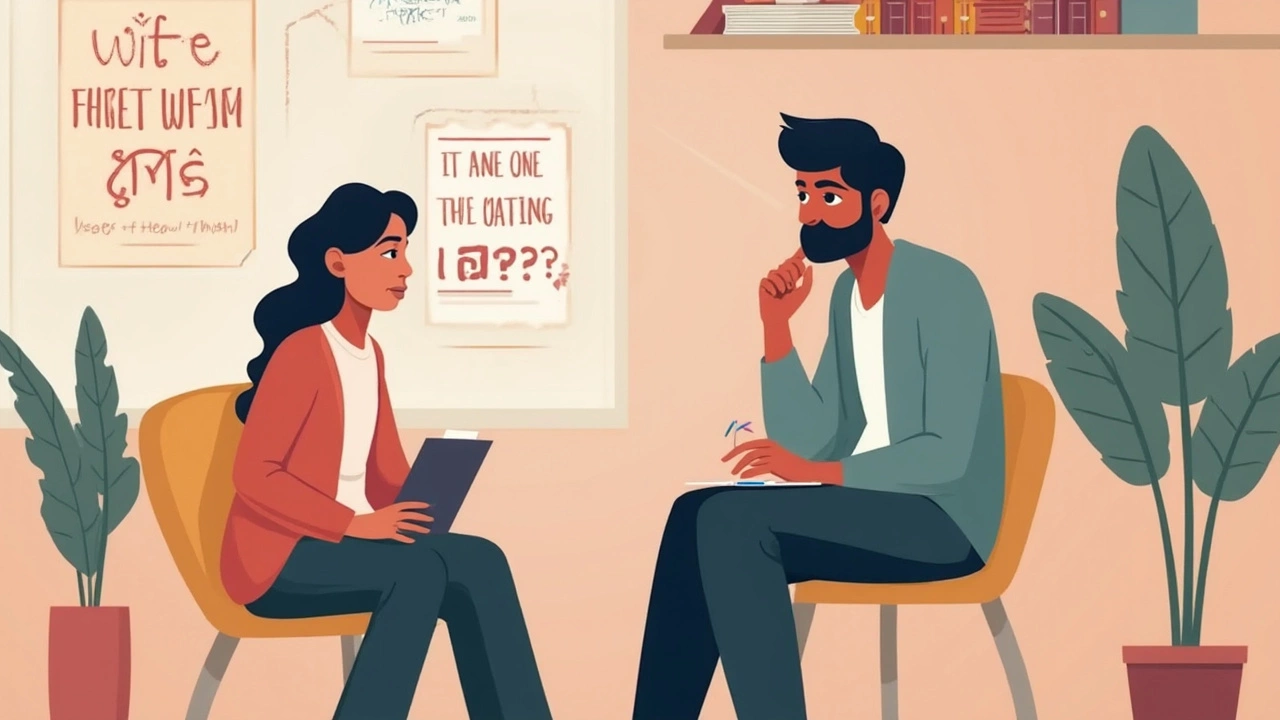There’s a lot of noise about therapy—some swear by it, others roll their eyes. At the end of the day, you just want to know: does therapy actually work, or is it just an expensive chat session? Forget the marketing slogans and Instagram wisdom. If you’re dealing with anxiety, depression, or stress that never seems to go away, you need real answers, not clichés.
Therapy isn’t magic, and it’s definitely not a one-size-fits-all deal. It’s more like tuning up your brain and habits—with help from someone trained to actually listen and cut through the fluff. The good news: studies from places like Harvard and the American Psychological Association show that around 75% of people who try therapy end up feeling better than folks who don’t. That’s not just placebo; it’s based on thousands of people reporting real changes after getting help.
Still, the experience can be wildly different depending on your expectations, your therapist, and your own effort. If you want straight talk on how therapy works, who it helps, and how to get real results, keep reading. We’re breaking down the facts so you don’t waste time (or money) walking in blind.
- What Is Therapy and Who's It For?
- Does Therapy Actually Work? The Science
- Different Types of Therapy: Which Fits You?
- How to Make Therapy Work for You
What Is Therapy and Who's It For?
So, what’s therapy beyond those scenes in movies with couches and notepads? Therapy—also called counseling or psychotherapy—is just a series of structured chats with a professional who’s trained to help you handle thoughts, feelings, or behaviors that get in the way of daily life. That pro is usually a psychologist, counselor, clinical social worker, or psychiatrist. Their main job is to help you break out of stuck patterns so you can start feeling and functioning better.
Is therapy only for people with a diagnosed mental health issue? Definitely not. While tons of folks with depression, anxiety, trauma, or addiction benefit, therapy is also for you if you’re stressed at work, struggling with relationships, or just need help handling life transitions. It’s even for people who aren’t in crisis but want to better understand themselves or improve habits.
Check out some common reasons people start therapy:
- Feeling anxious or down for weeks
- Going through a breakup, job loss, or family drama
- Worrying, overthinking, or trouble sleeping
- Struggling with addiction or unhealthy coping (drinking, eating, tech)
- Wanting to build better self-esteem or relationships
Here's a look at who usually tries therapy, according to U.S. national data from the CDC:
| Who Tries Therapy (%) | Percentage (2023) |
|---|---|
| Adults (18-44) | 21.2% |
| Adults (45-64) | 19.3% |
| Adults (65+) | 9.6% |
| Women | 24.7% |
| Men | 13.4% |
Pretty surprising, right? More women than men seek therapy, but guys—more are opening up than ever before. Age-wise, younger adults seem to go the most, probably because talking about mental health is less taboo now. Still, anyone can benefit, no matter their age or background.
At the end of the day, therapy is for anyone who wants support, tools, and new ways to deal with tough thoughts, emotions, or habits. You don’t need to hit rock bottom to consider it; you just need to want things to get better.
Does Therapy Actually Work? The Science
Let’s get one thing straight: a mountain of research shows that therapy actually helps lots of people. The idea isn’t just wishful thinking—there’s hard data behind it. For example, a major review from Johns Hopkins looked at hundreds of studies and found that people who went through talk therapy saw big drops in depression, anxiety, and even long-term stress.
Check out this snapshot from a few well-known sources:
| Condition | Average Improvement with Therapy | Source |
|---|---|---|
| Depression | 60–80% report improvement | National Institute of Mental Health |
| Anxiety | 70% see at least some relief | American Psychological Association |
| PTSD | Up to 67% see significant benefit | VA/U.S. Dept. of Veterans Affairs |
It isn’t a magic pill, but it’s solid: people who stick with therapy usually feel and function better. One thing that’s super important? The therapist’s skills matter a lot—studies show that a good relationship (they call it ‘therapeutic alliance’) between you and your therapist pretty much doubles your chances of getting real results. So, it’s not just about showing up; it’s about finding someone you vibe with.
Different approaches work for different issues. Cognitive Behavioral Therapy (CBT), for example, is the gold standard for depression and anxiety. Exposure therapy knocks down specific phobias. These aren’t just trends—they’re methods backed up by actual brain scans and real recovery stories. You don’t have to take my word for it; this is what researchers keep finding year after year.
One thing a lot of folks don’t realize: therapy’s biggest impact comes from showing up consistently and doing the homework. Yep, just talking in the room isn’t enough. It works because you start picking up new ways to think and deal with stuff—and it’s the real-world practice that drives the change.
If you want to know whether it’s all worth it, the numbers and the stories say yes, especially if you give it a fair shot and stick with it for a while.

Different Types of Therapy: Which Fits You?
Choosing a type of therapy can feel as confusing as picking a phone plan. There’s a lot more than lying on a couch and talking about your childhood. The right fit really depends on what’s bugging you and how you like to talk things out. Here’s a breakdown of some of the main therapy options so you don’t waste time guessing.
- Cognitive Behavioral Therapy (CBT): This is the most widely studied therapy out there. It’s practical—no endless soul-searching. CBT helps you spot negative thought patterns and ditch unhealthy habits. Research says CBT works well for anxiety, depression, OCD, and even sleep problems. Most sessions are goal-oriented, so you’ll know exactly what you’re working on each week.
- Dialectical Behavior Therapy (DBT): If you deal with mood swings, intense emotions, or borderline personality disorder, DBT goes a step beyond regular CBT. It mixes strategies for emotional control with stress tolerance and healthy relationships. DBT is also used a lot for folks with self-harm or suicidal thoughts.
- Psychodynamic Therapy: This is classic talk therapy—digging into how your past shapes your current feelings. It’s a good match if you want to understand yourself better and are okay with longer-term work. Studies show it can help with depression and relationship problems, but it’s less common for folks who want fast results.
- Humanistic Therapy: This one is all about self-acceptance and personal growth. Therapists here focus more on listening than advising. It’s less structured, which can be helpful if you don’t want pressure or strict goals every week.
- Group Therapy: Sometimes, sitting in a room with others facing similar struggles is just what you need. Group therapy is backed by research for helping with addiction, anxiety, and trauma. It’s usually cheaper than individual therapy, too.
- Online Therapy: Apps and video sessions make it easier to get therapy on your own schedule. Studies show online and texting-based sessions can be just as good as in-person, especially with issues like anxiety and mild depression.
Still unsure? Try asking yourself what you hope to get out of therapy. Do you want tools to deal with stress—fast? Go for CBT. Are you looking to figure out why certain patterns keep showing up in your life? Psychodynamic could be your style. If the first approach doesn’t click, keep trying—finding the right type or therapist is half the battle in therapy for mental health.
How to Make Therapy Work for You
Getting the most out of therapy isn’t about luck. It’s about small, practical moves anyone can use—even if you’re totally new to the process. Here’s how to actually see results and not just go through the motions.
- Be Honest—Even When It’s Awkward. You get results when you say what’s really on your mind, not just what sounds good. Your therapist isn’t there to judge, so say the stuff you’re scared to say out loud.
- Set Real Goals. Walk in with an idea of what you want to fix or understand. Even something basic like “I want to feel less anxious at work” gives you and your therapist a target. It’s easier to measure progress.
- Show Up Regularly. Skipping sessions breaks momentum. Research says weekly sessions show the most progress, especially in the first few months.
- Take Notes. After each session, write down any big takeaways or something your therapist said that hit home. It makes the lessons stick.
- Do the "Homework." Whether it's journaling, trying a new coping skill, or just thinking about a conversation, what you do between sessions often matters more than what happens in the room.
- Speak Up If It’s Not Working. Sometimes you just don’t click with a therapist. That’s normal. Most people try a few before they find the right one. If you feel stuck, talk about it—it’s your time and money.
Check this out—a real breakdown of what makes people successful in therapy, pulled straight from American Psychological Association findings:
| Factor | Success Rate (%) |
|---|---|
| Good Therapist-Client Fit | 62 |
| Clear Goal Setting | 54 |
| Session Regularity (weekly) | 71 |
| Active Participation/Openness | 68 |
You don’t have to be perfect, just intentional. The people who see the biggest gains from therapy are the ones driving the process, not just showing up. Want it to work? Treat it like something you’re building, not just something happening to you.
